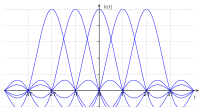
Photo from wikipedia
This paper investigates a context-adaptive sample acquisition strategy at sub-Nyquist sampling rate for wearable embedded sensor devices. Our approach can be applied to compressive sensing frameworks to minimise sampling and… Click to show full abstract
This paper investigates a context-adaptive sample acquisition strategy at sub-Nyquist sampling rate for wearable embedded sensor devices. Our approach can be applied to compressive sensing frameworks to minimise sampling and transmission costs. We consider a context estimate to represent the local signal structure and a feed-forward response model to continuously tune signal acquisition of an online sampling and transmission system. To evaluate our approach, we analysed the performance in different pattern recognition scenarios. We report three case studies here: (1) eating monitoring based on electromyography measurements in smart eyeglasses, (2) human activity recognition based on waist-worn inertial sensor data, and (3) heartbeat detection and arrhythmia classification based on single-lead electrocardiogram readings. Compared to conventional sub-Nyquist sampling, our context-adaptive approach saves between 13 to 22 percent of energy, while achieving similar pattern recognition performance and reconstruction error.
Journal Title: IEEE Transactions on Mobile Computing
Year Published: 2022
Link to full text (if available)
Share on Social Media: Sign Up to like & get
recommendations!